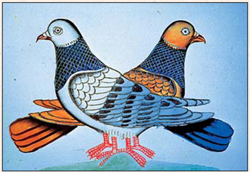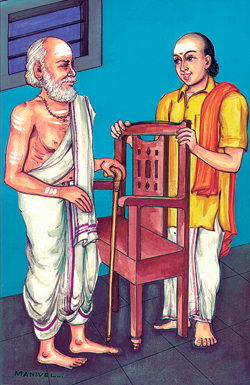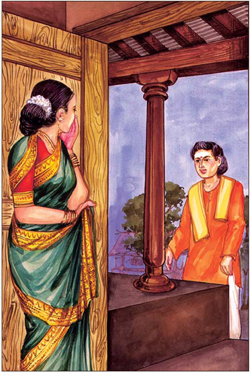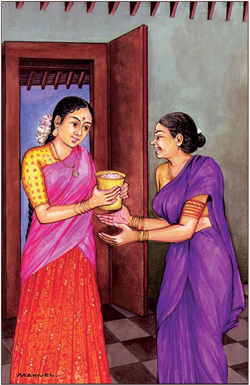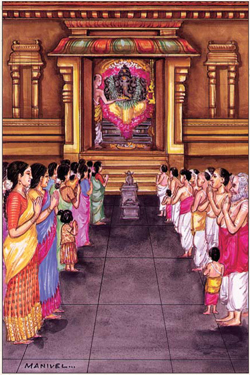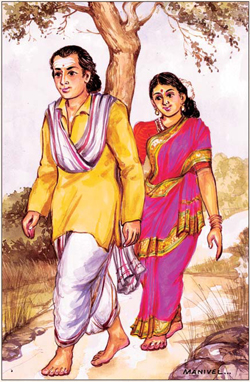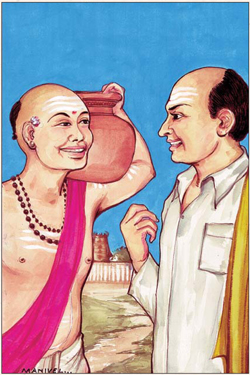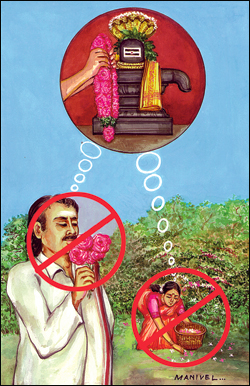
C H A P T E R 3 8§
Cultural Cues & Clues
_______________
Keys to Hindu Protocol for Novice Pilgrims to the Holy Lands
_______________
 EARLY EVERY INDIGENOUS PEOPLE on Earth is reevaluating, rediscovering and reappreciating its ancient ways, the traditions of the forefathers. Tradition is the best of the past that has been carried forward for the future. Among Hindus, too—a people of many nationalities comprising one sixth of the human race—the old, refined culture of simple, wholesome living is being recognized as a way of wisdom. As the age of information gathers speed at the dawn of the millenium, efforts are being made in every community to preserve and pass this knowledge on to future generations. This movement rides on a new pride, a renaissance of inspiration, a recuperation from centuries of British domination of India in which Hindu dignity was systematically undermined through the Macaulay education system. Today, as well, there is a burgeoning interest among Westerners to understand and adopt Hindu ways. Those seeking to fully live the Hindu culture who have been raised in non-Hindu environments face many challenges. Hindu culture is the pristine embodiment of a profound philosophy. It is an Eastern culture that gives freedom within the bounds of duty to elders, spouse and children. Western culture gives freedom to the individual, irrespective of the hurts he may inflict on others. The sense of duty is the foundation of Hindu culture, and in performing duty one finds freedom within oneself through yoga. Culture arises out of the attitudes, which are the outgrowth of the belief structure, of an individual or collective group. To be cultured means to exemplify the highest qualities of one’s society, religion or philosophy. There are countless ways the Hindu attitudes of compassion, respect and self-effacement are expressed. The keys below were developed by travelers to India who learned the hard way how to get along in a different culture. We summarize their cues and clues as a simple guide for novices and to assist Western seekers pilgrimaging in the holy lands to fit in as smoothly and unobtrusively as possible.§
EARLY EVERY INDIGENOUS PEOPLE on Earth is reevaluating, rediscovering and reappreciating its ancient ways, the traditions of the forefathers. Tradition is the best of the past that has been carried forward for the future. Among Hindus, too—a people of many nationalities comprising one sixth of the human race—the old, refined culture of simple, wholesome living is being recognized as a way of wisdom. As the age of information gathers speed at the dawn of the millenium, efforts are being made in every community to preserve and pass this knowledge on to future generations. This movement rides on a new pride, a renaissance of inspiration, a recuperation from centuries of British domination of India in which Hindu dignity was systematically undermined through the Macaulay education system. Today, as well, there is a burgeoning interest among Westerners to understand and adopt Hindu ways. Those seeking to fully live the Hindu culture who have been raised in non-Hindu environments face many challenges. Hindu culture is the pristine embodiment of a profound philosophy. It is an Eastern culture that gives freedom within the bounds of duty to elders, spouse and children. Western culture gives freedom to the individual, irrespective of the hurts he may inflict on others. The sense of duty is the foundation of Hindu culture, and in performing duty one finds freedom within oneself through yoga. Culture arises out of the attitudes, which are the outgrowth of the belief structure, of an individual or collective group. To be cultured means to exemplify the highest qualities of one’s society, religion or philosophy. There are countless ways the Hindu attitudes of compassion, respect and self-effacement are expressed. The keys below were developed by travelers to India who learned the hard way how to get along in a different culture. We summarize their cues and clues as a simple guide for novices and to assist Western seekers pilgrimaging in the holy lands to fit in as smoothly and unobtrusively as possible.§
Respect
Hindu culture is an expression of love, respect, honoring others and humbling one’s own ego so that the inner nature, which is naturally pure and modest, will shine forth. This is exemplified in the Hindu greeting in which we honor the Divinity within each person, knowing that God is everywhere and in all things. By this and other acts of reverence, such as the following, Sanatana Dharma’s truths are brought to the forefront of the mind many times each day. §
Respect for Elders: Respect for elders is a keystone of Hindu culture. This acknowledgment of seniority is demonstrated through endearing customs such as: sitting to the left of elders, bringing gifts on special occasions, not sitting while they are standing, not speaking excessively, not yawning or stretching, not putting one’s opinions forward strongly, not contradicting or arguing, seeking their advice and blessings, giving them first choice of seats, inviting them to take their food first or serving them first. §
Honoring Parents: Cultured Hindus serve their parents and close relatives all through life, honoring them through obedience and affection, and by providing support and comfort during old age. §
Name Protocol: Youngers never use the proper name of their elders. A Tamil younger brother, for example, refers to his elder brother as annai (brother), or periannai (elder brother). The elder may use the name of the younger. Children refer to adults as auntie or uncle. Adults refer to each other as elder or younger brother or simply brother (likewise for women). Only men the same age occasionally use the first name. A Hindu wife speaking of her husband, rather than using his given name, uses terms such as “my husband,” “him” or, for example, “Jothi’s father.” When addressing yogis, swamis or sadhakas, one uses the title, not personal pronouns nor the name alone). For example, one would not ask, “What do you want?” Instead, one would inquire, “What does swami want?” §
Touching Feet: One touches the feet of holy persons in recognition of their Divinity and attainment. A dancer touches the teacher’s feet before lessons. Children prostrate on the floor and touch the feet of their mother and father at special times, such as New Year’s day, birthdays and before parting for a journey. §
Hosting Guests in the Home
Hindu tradition lays great stress on the respect due to guests. All guests are God, Who comes in many forms. The greatest hurt is the thought that the host or hostess does not enjoy one’s presence in their home. Therefore, Hindus go out of their way to make each guest feel welcome. It is proper protocol to drop whatever one is doing, no matter how important, to entertain a visitor. One of the privileges of friendship in the East is being able to drop by any time without advance notice. Visitors may also leave in the same casual way, saying “I’ll be going now,” without necessarily even saying goodbye. §
Refreshments: It is customary to always offer your visitor something to eat and drink. Usually tea is served, but at least a glass of water should be offered (with a smile and apology). Likewise it is an insult for the guest to refuse food or beverages, or to not even sip a glass of water, even when time is short.§
Hosting: Children generally leave the room, with a smile, when guests enter. The mother remains close by to serve as needs arise. The father, if present, will speak with the guest. If not present, the mother and a son will fulfill this role, and if no son is present, the mother may act as hostess, but only with the accompaniment of someone close to the family. §
Wife Home Alone: If the lady of the house is home alone and a male visitor comes to see her husband, it is not proper for her to invite him in, nor for him to expect to enter. Rather, he will leave a message and take his leave.§
Punctuality: Eastern life is generally more relaxed than in the West. A good guideline is do not be surprised or offended if your guest arrives late or early. But be punctual in your own engagements, as this is appreciated.§
Giving Gifts: Gifts are always given when one stays over night as a guest in someone’s home. The value of the gift varies greatly, depending upon circumstance. It is proper to give a separate gift for the wife and the husband. The wife receives the nicest item.§
Duration of Stay: It is quite impolite to ask a guest how long he intends to stay, but it is good protocol for guests to make their plans and itinerary known from the outset.§
Exchange of Prana
Prana is the life principle, the subtle energy that emanates from the psychic force centers called chakras. Religious people, being sensitive to the various expressions of prana, are careful in how they manage their own energies and discriminating about the pranas they receive from the world around them. Prevailing pranas create a forcefield, positive or negative. The ideal Hindu home is a positive forcefield, kept strong through right thought, word and deed. §
Homecoming: Upon arriving home from work, it is customary to immediately bathe and enter the shrine room for special blessings to dispel worldly forces, quiet the mind and regain a centered, spiritual consciousness. §
Giving and Receiving: Giving and accepting things, presenting offerings to the Deity, etc., is properly done with both hands, to endow more energy to the object. This exchange of energies is vital for friendship and harmony through wholehearted release by the giver and conscious acceptance by the recipient.§
Throwing Things: Throwing an object to another person, even to a close friend, is improper. Cultured Hindus consider this crude, even mildly violent. §
Greetings: Hindu men traditionally greet one another with hands in anjali mudra (prayerful pose), then, with palms still held together, extend their hands to one another, in a two-handed handshake. This is a deliberate transfer of prana. The hands of one man, usually the less senior, are gently clasped between the other’s. Each looks smilingly into the other’s face while bowing slightly in humility. §
Doorways: It is inauspicious to converse inside or through doorways. Similarly, to exchange or give or lend an object, one first steps inside the room, or the recipient steps out of the room, so that both parties are in the same space. §
Auspiciousness: To ensure optimum timing for important events, Hindus guide their life by the map of auspiciousness, determined by astrology and indicated in the annual almanac, called panchanga. It provides vital information about the subtle but powerful affect of the planets and stars, indicating the prevailing forces of each day, the best times for innovations, travel, planting crops, routine work, personal retreat, seminars, marriages and other sacraments.§
Modesty & Reserve
Interactions in public between men and women are generally more restrained in Asian culture than in Western culture. For the most part, men socialize with men, and women with women. Men never touch women in public, such as helping a woman out of a car, unless the lady is very elderly or infirm. In the temple (see art), women worship on the left, and men on the right.§
HIndu Clothing: Traditional Hindu attire is modest and dignified, elegant yet never enticing, worn by staunch Hindus always at home, in the temple and at religious or cultural events. Women wear rich costumes and jewelry for religious and cultural events. They never expose breasts, navel or thighs. §
Chastity: Sexual purity is a cardinal virtue, controlling lust by remaining celibate when single and faithful in marriage. Boys and girls are taught to value and protect their chastity as a sacred treasure, and to save the special gift of intimacy for their future spouse. §
Chaperoning: Parents chaperone and monitor friendships of sons and daughters, closely guiding the private and social life of their children and teaching them the importance of wholesome companionship. Dating is traditionally not permitted, and marriages are arranged to ensure the most auspicious match.§
Fidelity: Sexual/psychic energies are carefully directed and contained in the close-knit family. The wife’s duty is to give her energy to her husband and make him strong. The husband protects and provides for the family. Children give their energy to their parents, their first gurus, obey and heed their good example. §
Displaying Affection: Married couples in Asia do not hug, hold hands or kiss in public. Even embracing at airports and train stations is out of the question. §
Propriety: It is improper to praise the beauty of another man’s wife (or daughter) lest one inadvertently suggest an improper interest in her. All older women are viewed as one’s mother and younger women as a sister. Also, one does not praise the beauty of a child or infant, protecting young ones from jealousies.§
Garlanding: Women do not garland men, and men do not garland women. Such exchanges are restricted to the marriage ceremony. However, a woman can garland her husband or her satguru. §
Womanly Protocol
Women in Hindu society are held in the highest regard, far more respected and protected, in truth, than in the West. This does not imply the kind of equality or participation in public interactions that are common in the West. A woman will often be given preferential treatment in India at such places as ticket counters. At meals, though, the men are usually expected to go first. Feminine refinements are expressed and protected through numerous customs, including the following.§
Modesty: The qualities traditionally most admired in Eastern women are shyness, self-effacement and modesty of dress and deportment. Self-assertive or bold tendencies are regarded with circumspection. §
Mixed Company: In mixed company, Hindu women will keep in the background and not participate freely in conversation. This, of course, differs among family and close friends. When male guests are in the home, the women will appear when it is proper. Visitors do not expect or ask to meet them. §
Walking with Husband: The wife walks a step or two behind her husband, or, if walking by his side, a step or two back, always giving him the lead. (In the West, the opposite is often true.) §
Serving Meals: At mealtime, women traditionally follow the ancient custom of serving the men first before eating. §
Chaperoning: It is customary for a woman leaving the home to always be accompanied, generally by her husband, mother-in-law, sister-in-law, mother, daughter, sister or another lady close to the family, or among a group of both men and women. Women in traditional areas rarely even walk across the street alone, unless they are older. Living alone, too, is unusual. §
Moving in Public: Generally, it is considered improper for women to speak with strangers on the street, much less strike up a casual conversation. Drinking or smoking in public is viewed as a sign of moral laxity.§
Shelter and Care: When away from home, husbands contact their wife each day to express their love and inquire about her day. §
Monthly Retreat: During their monthly period, Asian women do not prepare food, attend social gatherings or attend the temple or home shrine. §
Body Language
Hindus know that God is everywhere and in all things. This realization brings dynamic contentment and appreciation for the fact that life is to be lived joyously. This understanding is expressed in Hindu deportment, or “body language.” Every movement of the body, the face, hands, eyes, mouth, head, etc., has a meaning. Children and newcomers to the culture are taught to adopt refined body language and to become sensitive to the thoughts and feelings of others, who may be “talking” even when not speaking. §
Kindly Words and Countenance: Hindus strive to keep a pleasant expression on their face, a gentle smile and a kind word for everyone they meet through the day. They know in their heart of hearts that everything in the universe is in a perfect state of evolution at every point in time. §
Care in Sitting: It is a grave insult to sit with one’s legs outstretched toward a temple, a shrine or altar, or another person. One never sits higher than elders or holy persons. Worshiping in the kneeling pose is not acceptable among Hindus. Youths follow the example of traditional elders. §
Gestures of Humility: As stated in scripture, humility is strength not a weakness, pride is a weakness, not a strength. For example, orthodox Hindus will place their hand in front of their mouth when speaking to another, especially an elder, in a gesture of respect. Humility is expressed in ways of standing, sitting, listening, greeting others and more. §
Prideful Postures: Prideful postures are to be avoided, such as sitting with one foot placed on the opposite thigh, or with arms folded or chin held exceedingly high, or with hands on the hips with head cocked to the side. These gestures are signs of arrogance and a superiority complex.§
Pointing: Pointing with the forefinger of the right hand (or shaking the forefinger in emphasis) is never done. This is because the right hand possesses a powerful, aggressive pranic force. Pointing the index finger channels that force into a single stream. The harshness of this energy would be felt in the nerve system of the recipient. To show direction or emphasis, the entire hand is used as a pointer, with the palm up and the thumb held alongside the forefinger.§
Purity & Pollution
Purity and its opposite, pollution, are a fundamental part of Asian culture. While they imply a strong sense of physical cleanliness, their more important meanings extend to social, ceremonial, mental, emotional, psychic and spiritual contamination. Here are several ways purity is preserved. §
Cleanliness: Hindus keep their home environment clean and uncluttered to create a strong spiritual vibration and not attract negative forces. They seek fresh air and sunshine and surround themselves with beauty.§
Personal Health: Hindus keep strong and healthy through a balanced ayurvedic diet, moderate daily exercise, hatha yoga and vigorous work.§
Well-being: Mental and spiritual purity is maintained through daily meditation and worship, scriptural study, right living and right thinking.§
Purity and Food: In a market, one does not touch food one doesn’t intend to buy. One cooking food for others would never taste of a dish and then put the spoon back in the pot. One does not touch the lips to a water vessel used by others, nor lick postage stamps or offer to another food one has partaken of. §
Sanctified Food Leavings: The opposite is true in the case of the satguru’s food leavings. Food that the guru has tasted of is revered as sacred. This, and the water from the washing of the holy feet, is sought after and imbibed by devotees for the great spiritual blessings that it contains toward moksha. §
Offerings: One does not sniff flowers picked for offering—even the smell is for the Gods, not for us. Flowers that fall to the ground should not be offered. Offerings are carried with both hands on the right side of the body, so as to not be breathed on. All items are washed in preparation, then wrapped or covered.§
The Left Hand: The left hand is considered impure because it is used for personal hygiene by washing after answering the call of nature. Handing another person anything with the left hand is considered a subtle insult. §
Footwear: Shoes, being impure, are not worn inside the temple or home. Carrying shoes is also avoided. One apologizes immediately if one’s footwear touches another. This is done by touching the right hand to where the foot touched the other person, then touching the hand lightly to the left eye and then the right.
§
